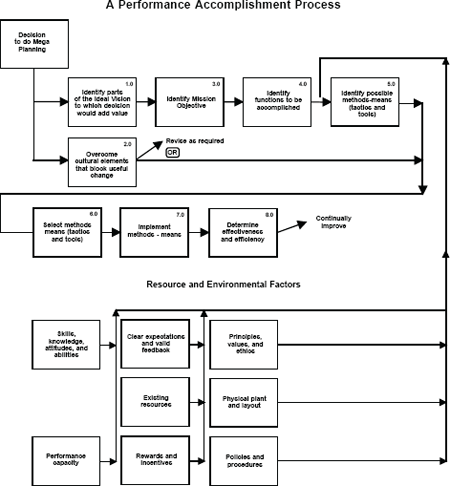A Management Plan for Mega Thinking and Planning
Figure 8.5 provides a flow chart, or management plan, for Mega Thinking and Planning.
After the decision to Mega plan,
| 1.0 | Identify the parts of the Ideal Vision you commit to deliver and move ever closer toward, and at the same time |
| 2.0 | Overcome cultural and individual elements that block useful planning and change, then |
| 3.0 | Identify the Mission Objective that states, in measurable terms, where you are headed and the criteria for measuring progress and if you have arrived, then |
| 4.0 | Identify functions to be accomplished: what building block results have to be completed within your organization to get from What Is to What Should Be, then |
| 5.0 | Identify possible methods-means (tactics, tools, approaches, programs, activities), and then |
| 6.0 | Select the methods-means identified in 5.0 (perhaps using costs-consequences tools to project possible impact and value added), and then |
| 7.0 | Implement the methods-means and track the progress based on the performance criteria derived for each function and task, and then |
| 8.0 | Determine the effectiveness and efficiency so that you will continually improve. This step of continually improving actually goes on at all times; at any point in the management plan when accomplishments don’t meet the requirements, revise then and there. |
In the lower part of this figure are listed some of the basic resources required for successful Mega Thinking and Planning.
Figure 8.5. A management plan for Mega Thinking and Planning.
Action Steps
1. Apply the three guides and do that consistently and with the rigor involved.
2. Don’t “go native” and fall back into the conventional methods used by others for strategic planning and needs assessment. It might be more comfortable at first but it will not lead to your success.
3. The tools and techniques provided in this book will serve you well. Use them.
Endnotes
1. Kaufman, R. (2006). Change, choices, and consequences: A guide to Mega Thinking and Planning. Amherst, MA: HRD Press, Inc.
2. Based on Kaufman, R. (1998). Strategic thinking: A guide to identifying and solving problems (revised). Washington, DC and Arlington, VA: The International Society for Performance Improvement and the American Society for Training and Development.
3. All organizations, public and private, have the same Ideal Vision. Each organization is responsible for adding measurable value to our shared communities and society.
4. Many so-called “needs assessment” models exist. Not all really deal with needs. There are a number of so-called needs assessment models and processes available. The question any adopter should ask is “How many of the Organizational Elements are vital to my success?” A comparison of various popular models of so-called and actual needs assessments may be found in:
Leigh, D., Watkins, R., Platt, W., and Kaufman, R. (2000). Alternate models of needs assessment: A digest, review, and comparison of needs assessment literature. Human Resource Development Quarterly, 11(1), pp. 87–93.
Watkins, R., Leigh, D., Platt, W., & Kaufman, R. (1998). Needs assessment: A digest, review, and comparison of needs assessment literature. Performance Improvement, 37(7), pp. 40–53.
Watkins, R., Leigh, D., & Kaufman, R. (1999). Choosing a needs assessment model. In Silberman, M. Team and Organizational Development Sourcebook. New York: McGraw Hill.
5. Information on “system analysis” tools is provided in:
Kaufman, R. (1998). Strategic thinking: A guide to identifying and solving problems (revised). Washington, DC and Arlington, VA: The International Society for Performance Improvement and the American Society for Training and Development. (Recipient of the 2001 International Society for Performance Improvement “Outstanding Instructional Communication Award.”) Also, Spanish edition, El Pensamiento Estrategico. Centro de Estudios: Roman Arces, S.A., Madrid, Spain.
Kaufman, R. (2000). Mega Planning: Practical tools for organizational success. Thousand Oaks, CA: Sage Publications. Also Planificación Mega: Herramientas practices paral el exito organizacional. (2004). Traducción de Sonia Agut. Universitat Jaume I, Castelló de la Plana, Espana.
Kaufman, R., Oakley-Browne, H., Watkins, R., & Leigh, D. (2003). Practical strategic planning: Aligning people, performance, and payoffs. San Francisco, CA: Jossey-Bass/Pfeiffer.
6. An original version of this was developed by Dr. Ingrid Guerra-Lopez as part of a presentation on Mega Planning for The Center for Needs Assessment and Planning. Florida State University.
7. Kaufman, R. (1992). Strategic planning plus: An organizational guide (revised). Newbury Park, CA: Sage Publishing.
Kaufman, R. (1998). Strategic thinking: A guide to identifying and solving problems (revised). Washington, D.C., and Arlington, VA: The International Society for Performance Improvement and the American Society for Training and Development.
Kaufman, R. (2000). Mega Planning: Practical tools for organizational success. Thousand Oaks, CA: Sage Publications.
Kaufman, R. (2006). Change, choices, and consequences: A guide to Mega Thinking and Planning. Amherst, MA: HRD Press, Inc.

